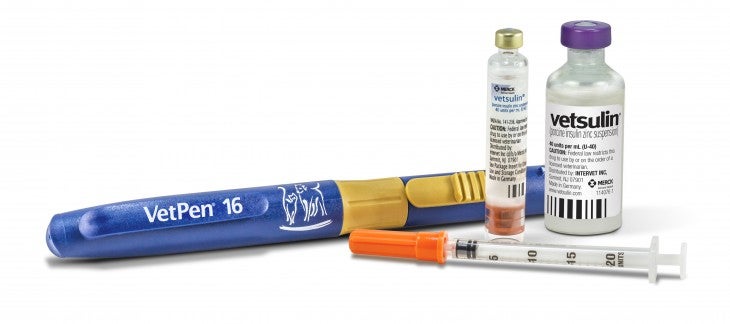It is always disappointing to hear that your pet has diabetes, but rest assured that Vetsulin, an FDA-approved insulin for diabetic dogs and cats, can help manage your pet’s disease. Vetsulin® is the first and only insulin approved by the US Food and Drug Administration for treating both canine and feline diabetes mellitus.
Diabetes Mellitus is a disease of the pancreas, this is an organ located by the stomach, it’s a small but vital organ and has two significant group of cells. One group produces the enzymes necessary for digestion, and the other group (called beta-cells) produces the insulin hormone. Insulin regulates the level of glucose in the bloodstream and controls the delivery of glucose to tissues of the body. In few words, failure of the pancreas to regulate blood sugar is the cause for diabetes mellitus.
Four main symptoms of uncomplicated diabetes mellitus are:
The Vetsulin formula allows for a more continuous utilization of glucose to support the body’s basic functions. Vetsulin is administered subcutaneously once daily initially, although two-thirds of dogs require twice-daily administration for effective diabetes management.
Vetsulin is an intermediate-acting form of insulin that contains 35% amorphous insulin for rapid onset of activity. In cats, the peak activity following subcutaneous administration of Vetsulin occurs between 1.5 and 8 hours (with an average of about 4 hours, and the duration of activity varies between 8 and 12 hours. This is why, in cats, Vetsulin is initially administered twice daily rather than once daily.
In Dogs:
The initial recommended Vetsulin dose is 0.5 IU insulin/kg of body weight. This dose should be given once daily concurrently with or right after a meal.
In Cats:
The initial recommended dose 1 to 2 IU per injection. The injections should be given twice daily at approximately 12 hour intervals. For cats fed twice daily, the injections should be given with, or right after each meal.
Vetsulin insulin and human insulin are different because they have different amino acid sequence. Its similar structure may provide more effective regulation of blood glucose and decreases the risk of anti-insulin antibody development in dogs. Unlike the dog, anti-insulin antibodies do not appear to be a problem in cats.
Any change in insulin should be made cautiously and only under a veterinarian’s supervision. Changes in insulin strength, manufacturer, type, species (animal, human), or method of manufacturer DNA versus animal-source insulin) may result in the need for a change in dosage.
It is highly recommended by veterinarians and pharmacies to use iPetGlucose Meter Kit for DOGS & CATS, it’s very easy to use and 99% accurate. Measuring your pet’s blood glucose levels has never been easier, monitoring kit is calibrated specifically for diabetic dogs & cats to ensure its accuracy. Kit’s built-in memory stores 28 test results and its light weight allows you to take it with you everywhere you go.
It is very important to know Vetsulin should not be used in dogs or cats known to have a systemic allergy to pork or pork products. Vetsulin is contraindicated during periods of hypoglycemia. Over dosage can result in profound hypoglycemia and death. The safety and effectiveness of Vetsulin in puppies and kittens, breeding, pregnant, and lactating dogs and cats has not been evaluated.





